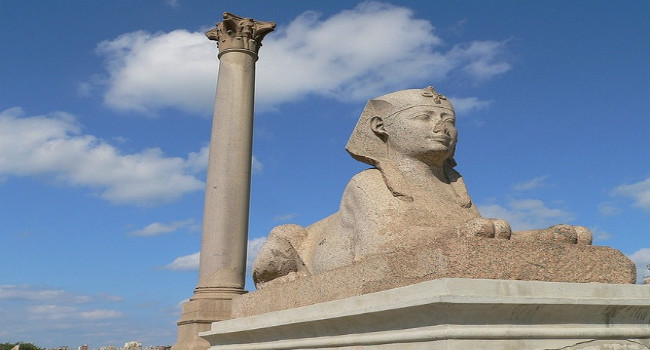Unveiling Pompey's Pillar in Alexandria's Serapeum
Pompey's Pillar is a remarkable ancient monument that stands as a testament to the rich history of Alexandria, Egypt. Rising proudly towards the sky, this majestic pillar has captured the imaginations of visitors for centuries. Let's delve into the fascinating story of Pompey's Pillar, exploring its history, architectural features, and cultural significance.
A Historical Landmark
Pompey's Pillar, also known as the Column of Diocletian, was erected in the late 3rd century AD to honor the Roman Emperor Diocletian. Despite its name, the pillar has no direct connection to the Roman general Pompey the Great. Its construction was part of a broader effort to embellish the city of Alexandria and commemorate the emperor's achievements.
The Architectural Marvel
Standing at a towering height of over 25 meters (82 feet) and crafted from a single block of red Aswan granite, Pompey's Pillar is an awe-inspiring architectural marvel. The pillar is a prime example of Roman design and engineering excellence. The monolithic shaft features intricate details, including fluted sides and a Corinthian capital adorned with acanthus leaves and scrolls.
Ancient Egyptian Influences
While Pompey's Pillar reflects Roman architectural style, it also incorporates elements inspired by ancient Egyptian design. The use of Aswan granite, a material often associated with ancient Egyptian monuments, symbolizes the connection between the Roman Empire and the grandeur of ancient Egypt. This blending of architectural influences makes Pompey's Pillar a captivating sight to behold.
Myths and Legends
As with many ancient landmarks, Pompey's Pillar is surrounded by myths and legends. One popular tale suggests that the pillar was used for public executions during the Roman period. However, there is no historical evidence to support this claim. Another legend states that the ashes of Pompey the Great were placed in a golden urn atop the pillar. While historically inaccurate, these stories add an air of mystery and intrigue to the monument.
A Symbol of Alexandria's Past
Pompey's Pillar serves as a powerful symbol of Alexandria's rich past. It stands as a reminder of the city's significance as a thriving center of trade and culture during the Roman era. The pillar's location, within the ancient city's ancient Serapeum complex, further emphasizes its historical and cultural importance.
Visiting Pompey's Pillar
Today, Pompey's Pillar stands as one of Alexandria's most cherished tourist attractions. Visitors can marvel at its grandeur and explore the surrounding archaeological site. The monument offers a panoramic view of the city, allowing visitors to imagine Alexandria's bustling streets and vibrant atmosphere during ancient times. The site surrounding Pompey's Pillar also features remnants of ancient structures, including the Serapeum, an ancient temple dedicated to the god Serapis. These archaeological remains provide further insight into the city's past and offer a glimpse into the life and culture of ancient Alexandria.
Preserving an Ancient Treasure
Preservation efforts play a crucial role in safeguarding Pompey's Pillar for future generations. Restoration projects and ongoing maintenance work help protect the monument from the effects of weathering and human activity. These efforts ensure that this iconic pillar remains intact, allowing visitors to continue marveling at its historical significance and architectural splendor.
Pompey's Pillar stands as a remarkable testament to Alexandria's ancient history. Its towering presence, stunning architecture, and cultural significance make it a must-visit destination for history enthusiasts and travelers alike
Egypt Tours Including Pompey's Pillar
| Tour | Itinerary | Price |
|---|---|---|
| Cairo City Breaks | 3 Days | $ 255 |
| Cairo Private Tours | 4 Days | $ 429 |
| Cairo Wheelchair Accessible Tours | 5 Days | $ 625 |
| Cairo Holiday Packages | 5 Days | $ 819 |
| Egypt Overland Tours | 8 Days | $ 1105 |
| Cairo and Nile Cruise for Disabled Travellers | 8 Days | $ 3385 |
